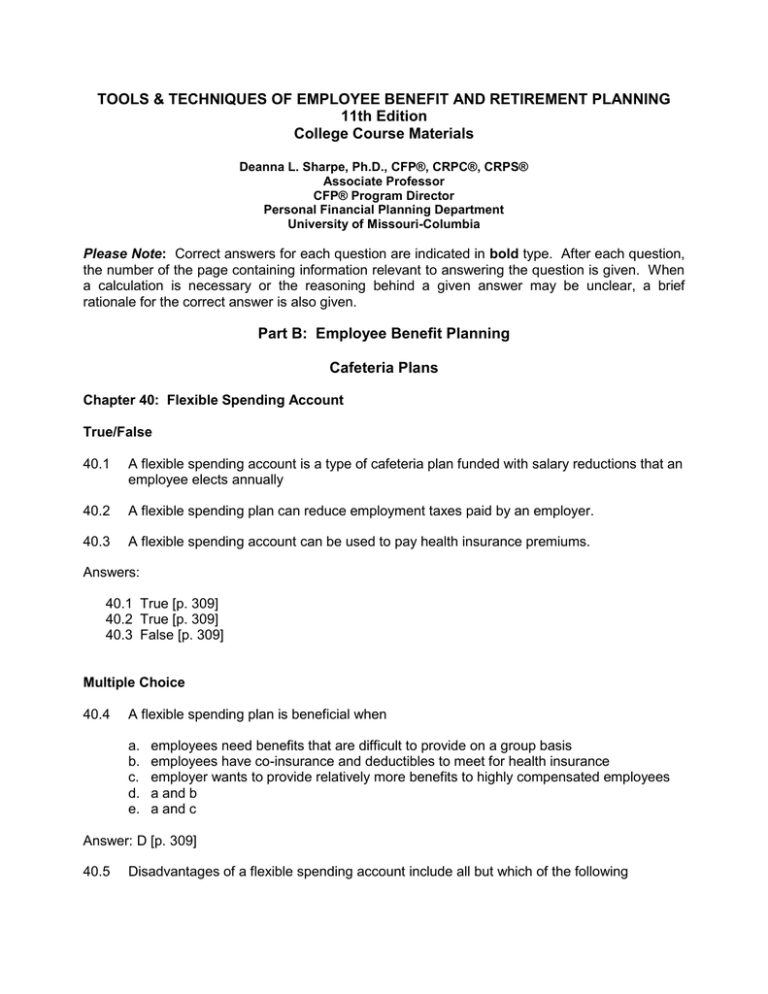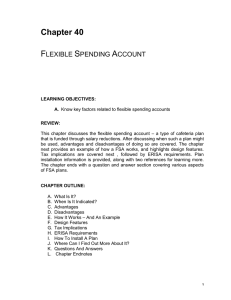TOOLS & TECHNIQUES OF EMPLOYEE BENEFIT AND RETIREMENT PLANNING 11th Edition
advertisement

TOOLS & TECHNIQUES OF EMPLOYEE BENEFIT AND RETIREMENT PLANNING 11th Edition College Course Materials Deanna L. Sharpe, Ph.D., CFP®, CRPC®, CRPS® Associate Professor CFP® Program Director Personal Financial Planning Department University of Missouri-Columbia Please Note: Correct answers for each question are indicated in bold type. After each question, the number of the page containing information relevant to answering the question is given. When a calculation is necessary or the reasoning behind a given answer may be unclear, a brief rationale for the correct answer is also given. Part B: Employee Benefit Planning Cafeteria Plans Chapter 40: Flexible Spending Account True/False 40.1 A flexible spending account is a type of cafeteria plan funded with salary reductions that an employee elects annually 40.2 A flexible spending plan can reduce employment taxes paid by an employer. 40.3 A flexible spending account can be used to pay health insurance premiums. Answers: 40.1 True [p. 309] 40.2 True [p. 309] 40.3 False [p. 309] Multiple Choice 40.4 A flexible spending plan is beneficial when a. b. c. d. e. employees need benefits that are difficult to provide on a group basis employees have co-insurance and deductibles to meet for health insurance employer wants to provide relatively more benefits to highly compensated employees a and b a and c Answer: D [p. 309] 40.5 Disadvantages of a flexible spending account include all but which of the following a. b. c. d. e. a flexible spending account must meet complex nondiscrimination requirements flexible spending accounts are not practical for businesses with a few employees employer must contribute to employee flexible spending accounts flexible spending accounts must be used within a calendar year or forfeited administration of a flexible spending account plan is relatively more expensive for an employer than a standard benefit package Answer: C [p. 310] 40.6 Which of the following benefits are not allowed in a flexible spending account? a. b. c. d. e. dental care long term care dependent care reimbursement purchase of eyeglasses purchase of dental care Answer: B [p. 310] Application 40.7 The Aglow Candle Shoppe has 5 full-time and 2 part-time employees. The two part-time employees and one full time employee are college students. A flexible spending plan would be an appropriate employee benefit for this business. a. true b. false Answer: B [p. 309] 40.8 Bill Martin had $5000 in his flexible spending account this year to cover dental, medical, and dependent care expenses. During this year, his qualified expenses under the plan were $1,000 in dental expenses, $1,500 in medical expenses and $2,000 in dependent care expenses. He anticipates $500 in dental, $2,000 in medical and $3,000 in dependent care expenses for next year. a. Bill can roll his unused dollars to the next plan year b. Bill forfeits $500 c. Bill’s dental and medical expenses are paid in full, but only part of the dependent care expenses are covered since $2000 exceeds one-third of his contribution for the three types of expenses d. If Bill has an emergency related to a covered expense over $500, he can contribute more to his plan before the close of the plan year to cover the additional expenses e. Bill can withdraw unspent funds at year end, add them to his ordinary income, and pay taxes accordingly Answer: B [p. 310] 40.9 In November of last year, Alice Cramer directed her employer to deposit $400 per month via salary reduction into a flexible spending account (FSA) to cover dependent care expenses for her 2 year old daughter, Shasta. The FSA year runs from January to December. Her husband lost his job in August of this year. Alice and her husband decide they can save money if he takes care of Shasta during the day and gets a part-time job in the evening. a. Alice must wait until November of this year to make any changes in her FSA b. Alice’s situation is not a qualifying event. Income tax on all prior salary reductions for the year will be charged if Alice changes her FSA salary reduction during the benefit year. c. Alice’s situation is not a qualifying event. She must treat the funds that formerly went to the salary reduction FSA as ordinary income and pay taxes accordingly d. Alice’s situation is a qualifying event. She will be assessed a penalty of 10% of her salary reduction if she changes her FSA salary reduction during the benefit year. e. Alice’s situation is a qualifying event; she can make a change in her FSA salary reduction without penalty Answer: E [p. 312] 40.10 Erin Lauder elected in December of last year to have $300 a month redirected from her salary to her flexible spending account with her employer, Barron Corporation. In January of this year, Erin was in a car accident. Her medical expenses that were covered by her FSA plan amounted to $900, but she had only deposited $300 into her FSA so far this year. a. b. c. d. Erin can only get $300 reimbursement from her FSA in January Erin can get $900 from her FSA, but $600 will be taxed as ordinary income Erin can get $900, but must be willing to accept $300 per month for 3 months Erin can get $900, but her employer is at risk of loss if Erin leaves the Corporation before she has deposited an amount equivalent to her withdrawal e. Erin can get $900, but must wait until the beginning of April when she has $900 deposited into her account Answer: D [p. 312]




